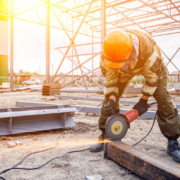 It’s easy, with everything going on in a typical office, to move safety and risk management to the back burner. After all, your employees work in an office with computers, not on a construction site or manufacturing facility with dangerous machinery. Yet it’s important to know that most on-the-job-injuries happen in offices. Surprised? It’s true.
It’s easy, with everything going on in a typical office, to move safety and risk management to the back burner. After all, your employees work in an office with computers, not on a construction site or manufacturing facility with dangerous machinery. Yet it’s important to know that most on-the-job-injuries happen in offices. Surprised? It’s true.
Wherever they happen, on-the-job injuries can be costly — to the employer and employee. That’s why preventing them should be a priority for even the smallest of companies. At Accurate Protection, we specialize in working with companies that don’t have the resources to employ a full-time risk manager. We consider ourselves to be outsourced risk managers for growth-oriented medium-sized companies.
We provide risk-reducing strategies, programs and comprehensive safety materials that can reduce your company’s chance for loss. Once you’re better at managing your company’s risks, we educate underwriters about your company and build positive carrier relationships on your behalf. By demonstrating your commitment to decrease risk and support safety, we can help your company realize lower long-term insurance premiums.
What are some of the ways employees injure themselves in the office environment? At the office, slips, trips and falls are the most common hazards. Look around for uneven surfaces, torn carpet or anything else that could cause someone to trip and fall. Clean up any spills immediately and address any surfaces that become slippery, especially during the winter months. You may want to consider having an ergonomics expert make sure your workstations are designed so that they meet basic rules for preventing repetitive injuries. Lifting heavy objects — the wrong way — can also result in injuries at the office, so it’s important to help employees understand how to lift safely.
If your employees drive for business, make sure you have a safe-driving policy and consider banning cellphone use by employees who drive on the job. If they work with potentially dangerous machinery and/or equipment, you’ll need an effective safety plan designed specifically to keep employees well-rested, trained and injury-free. Another important thing you can do? Create a culture of safety where employees know they can take breaks to stretch and rest their muscles and their eyes.
Lastly, during the global pandemic, it’s important to pay attention to new OSHA guidance regarding the spread of COVID-19. It’s only guidance, not law, but it’s important for employers to read, understand and implement. It’s part of creating a safe working environment for all employees.
Want to learn more? Visit our website: https://accurateprotection.com/. And give us a call at (404) 907-2121 x701 .



 How do you feel about remote work? Research shows that telecommuting has numerous benefits to employers (such as more productive and engaged workers) and employees (less time and cost involved in commuting and greater work-life balance). Yet Gallup research suggests that telecommuting yields the most benefits to employees and employers when workers do not spend 100 percent of their time at home. Does this surprise you?
How do you feel about remote work? Research shows that telecommuting has numerous benefits to employers (such as more productive and engaged workers) and employees (less time and cost involved in commuting and greater work-life balance). Yet Gallup research suggests that telecommuting yields the most benefits to employees and employers when workers do not spend 100 percent of their time at home. Does this surprise you?
 Your small business is growing fast. Do you have a plan in place to manage the added risk that comes with more customers and more employees? There’s nothing quite like an on-the-job accident, a careless mistake or a legal claim to create hardship for even the most successful companies.
Your small business is growing fast. Do you have a plan in place to manage the added risk that comes with more customers and more employees? There’s nothing quite like an on-the-job accident, a careless mistake or a legal claim to create hardship for even the most successful companies.
 Feedback is critically important in any organization because it helps employees at all levels identify areas in which they stand out and skills they need to develop. Yet providing face-to-face feedback remains one of the most challenging aspects of leadership. And that’s true whether you’re a CEO or a lower-level leader. Positive feedback is typically easy to provide, of course, but it’s the negative feedback that’s often so much more difficult to deliver effectively, especially in person. It’s simple: Many people have trouble delivering criticism. And there’s always the risk that the employee will respond unfavorably, creating conflict — something we as humans try to avoid. It’s no surprise, then, that surveys show that many business leaders feel uncomfortable providing feedback to their employees, either during scheduled review sessions or on a day-to-day basis. Consider data from Harris Poll:
Feedback is critically important in any organization because it helps employees at all levels identify areas in which they stand out and skills they need to develop. Yet providing face-to-face feedback remains one of the most challenging aspects of leadership. And that’s true whether you’re a CEO or a lower-level leader. Positive feedback is typically easy to provide, of course, but it’s the negative feedback that’s often so much more difficult to deliver effectively, especially in person. It’s simple: Many people have trouble delivering criticism. And there’s always the risk that the employee will respond unfavorably, creating conflict — something we as humans try to avoid. It’s no surprise, then, that surveys show that many business leaders feel uncomfortable providing feedback to their employees, either during scheduled review sessions or on a day-to-day basis. Consider data from Harris Poll:
 The statistics are startling: It’s estimated that two-thirds of all small businesses have no plan in place in the event of a major business disruption or disaster. And according to a report from the Federal Emergency Management Agency (FEMA), 40% of businesses do not reopen following a disaster and another 25% fail within one year after one.
The statistics are startling: It’s estimated that two-thirds of all small businesses have no plan in place in the event of a major business disruption or disaster. And according to a report from the Federal Emergency Management Agency (FEMA), 40% of businesses do not reopen following a disaster and another 25% fail within one year after one.
 Long days and irregular work schedules have become increasingly common in today’s business world. And during the global pandemic, many essential workers — from health care employees to grocery workers — have seen disruptions in both how and when they work, leaving even less time to sleep and recharge.
Long days and irregular work schedules have become increasingly common in today’s business world. And during the global pandemic, many essential workers — from health care employees to grocery workers — have seen disruptions in both how and when they work, leaving even less time to sleep and recharge.
 Do you like to make New Year’s resolutions? Studies show that most Americans make an average of three to five goals each January. The problem: Most resolutions are cast aside by the end of February.
Do you like to make New Year’s resolutions? Studies show that most Americans make an average of three to five goals each January. The problem: Most resolutions are cast aside by the end of February.
 Do your employees like to work from home? Do you? New Gallup data shows that nearly two-thirds of U.S. workers who have been performing their jobs remotely during the COVID-19 outbreak would like to continue to do so at least part of the week when the global pandemic is over.
Do your employees like to work from home? Do you? New Gallup data shows that nearly two-thirds of U.S. workers who have been performing their jobs remotely during the COVID-19 outbreak would like to continue to do so at least part of the week when the global pandemic is over.
 We all know we should be using strong passwords. But studies show that many of us are still using passwords like ’123456.’ That was the most-used password nationwide last year, followed by ‘password,’ ’123456789,’ ’12345678′ and ’12345′. Rounding out the top 10: ’111111,’ ’1234567,’ sunshine,’ ‘qwerty,’ and ‘iloveyou’. Chances are, even if your password skills are much better than average, they could still use some improvement. That’s why we wanted to share with you four simple steps to a stronger password.
We all know we should be using strong passwords. But studies show that many of us are still using passwords like ’123456.’ That was the most-used password nationwide last year, followed by ‘password,’ ’123456789,’ ’12345678′ and ’12345′. Rounding out the top 10: ’111111,’ ’1234567,’ sunshine,’ ‘qwerty,’ and ‘iloveyou’. Chances are, even if your password skills are much better than average, they could still use some improvement. That’s why we wanted to share with you four simple steps to a stronger password.
 Think companies that have primarily office workers don’t have to worry much about workplace safety, on-the-job injuries or risk management? Think again! Accidents and incidents happen in all kinds of U.S. companies — not just at construction sites or in manufacturing facilities.
Think companies that have primarily office workers don’t have to worry much about workplace safety, on-the-job injuries or risk management? Think again! Accidents and incidents happen in all kinds of U.S. companies — not just at construction sites or in manufacturing facilities.